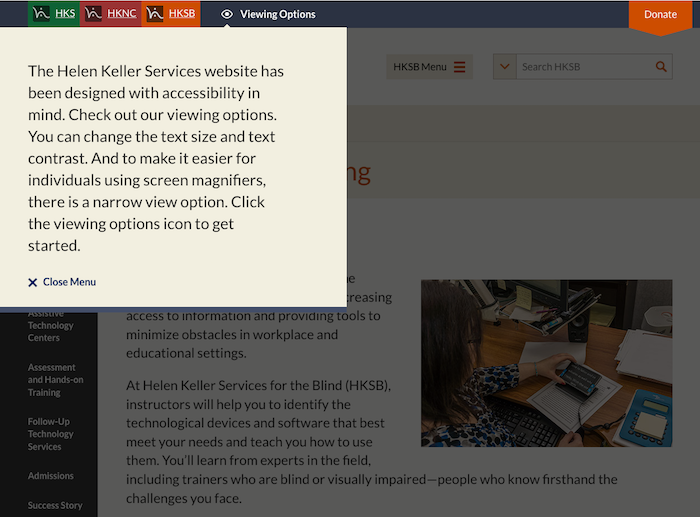Ecommerce Accessibility Audit Helps Bring Online Shopping to All

To illustrate the value of an ecommerce accessibility audit, a service provided by Command C, let’s start with an analogy.
Imagine walking down a city sidewalk and coming to the corner. It’s likely to have a corner curb cut, where the sidewalk lowers to the road. Curb cuts were created to help people in wheelchairs maneuver between the street and the sidewalk. Certainly people use them in this way, but think about all the other people who benefit–people with strollers or delivery workers with rolling carts, for example. In the process of making accessibility easier for one population, city developers have made an experience better for others, too. This is the goal we’re striving for in ecommerce accessibility.
Related: Unite 2018 + Future of Commerce
An estimated 12-19% of the population lives with a disability. Some disabilities are temporary, while others are lifelong. Everyone has a right to fully experience online life, and the World Wide Web Consortium (W3C) created the Web Accessibility Initiative (WAI) standards to ensure this right for all. To this end, they developed the Web Content Accessibility Guidelines around a set of four principles. Let’s take a look.
1. Perceivable: people can see and hear web content

As Command C’s Lead Tech, Tiffany Kuchta, explains, “Accessibility exists on a spectrum.” The W3C guidelines have three levels: A, 2A, and 3A. Level A represents a good, standard level of accessibility. Level 3A is assigned to sites with exceptional accessibility. Most ecommerce companies can get to Level A without too much work. Level 3A, on the other hand, often requires significant development.
One easy way to make web content perceivable is to add alternative (alt) text for images. People with no or low vision often navigate the web through screen readers that read content aloud. (To get a sense of what this is like, download Google ChromeVox for your Chrome browser.)
Screen readers cull through a site and announce its content, including photos. The reader will speak the alt text provided for each image. The alt text is more than the title of a photo; it’s a description of the photo.
Think about the photos on your ecommerce site. For instance, if you sell deck furniture, you’ll likely have a lifestyle photo that shows people enjoying a summer day outside on the furniture. The alt text for this photo should describe the fun scene. Shoppers with and without vision want to understand how your products will improve their lives.
Keep in mind that accessibility is an ongoing effort, particularly from a content strategy standpoint. For example, are your site videos captioned? Are transcripts available and easy to access? We encourage retailers to adopt the mindset of “let’s make this available to all” for new content.
2. Operable: people can access sites by typing or voice

In making web content operable, we’re talking about allowing users to access information by typing or by voice. Returning to the levels of accessibility compliance, let’s talk about an example we all do regularly online: filing out a form. In ecommerce, we do this during purchase checkout.
At Level A, if a shopper makes an error on an online form, the site will tell him or her that there’s an error. Most sites comply with this because no retailer wants forms that are unusable.
At Level 3A, when the shopper starts typing an error, they are given immediate feedback, “this is incorrect.” The site will do everything it can to prohibit the shopper from submitting an error. They are given the opportunity correct the error, and usually will not be able to continue until it is resolved. Input assistance that confirms with Level 3A standards may also be reversible, i.e. UNDO options exist for all submissions.
It’s frustrating for anyone to have to backtrack or resubmit a form due to a mistake. But for someone exerting extra effort due to a disability, these kind of glitches create hardship. This is just one example, but a useful one for thinking about how to make the actions on your site frictionless.
3. Understandable: sites use clear, common language

The understandable principle can be so easy. But sometimes we complicate things. Instead employ the mantra, “keep it simple.” As William Zissner wrote in On Writing Well, “Clutter is the laborious phrase that has pushed out the short word that means the same thing. Beware, then, of the long word that’s no better than the short word: “assistance” (help), “numerous” (many), “facilitate” (ease), “individual” (man or woman), “remainder” (rest), “initial” (first), etc.”
Make sure to keep the language on your ecommerce site clear and easy to understand. Again, this approach is more needed by some than others, but it’s best for all!
4. Robust: people use variety of assistive technologies

When Tiffany describes making sites accessible to all kinds of assistive technology, she emphasizes, “You want to open the door to as many devices as possible.” To get a sense of what an all-encompassing approach looks like, checkout Apple’s commitment to accessibility.
For instance, consider skip navigation. We’re all familiar with the experience of navigating through a website and clicking on the company logo to get back to the homepage.
For people using the web with a screen reader, however, it’s imperative to include skip navigation, a simple link that says “skip to the main page content” in the coding. Otherwise, as the person browses the content, the screen reader will read the entire menu structure and all header content to the user again. A user with full vision doesn’t have to look at all the items in the menu again every time she goes to a new page. Likewise, people with limited vision shouldn’t have to listen to a bot read 200 navigation links.
Now we’re giving a similar ecommerce experience to users with and without sight. The aim is to create an experience that is equivalent–not separate or stripped down. Indeed, this is the goal for all aspects of accessibility, whether it’s regarding vision, mobility, or other senses.
Write an Ecommerce Accessibility Statement

We heartedly encourage retailers to be transparent in their efforts towards accessibility. One of the best ways is by writing and sharing an accessibility statement on your online store.
Tiffany explains that the statement’s messaging should communicate ideas like this, “We’re actively doing the best we can to make this site as usable as possible. We’re also open to you telling us what you can’t navigate.
At the same time, we don’t want to put the burden on you to tell us about it. So we’ll continue to make improvements. We want this to be as good as it can be. Our door is open. We’re in this with you.”
That’s a great jumping off point. Merchants can wordsmith these concepts as they wish. As an example, take a look at how Grinnell College handles their accessibility statement.
Conclusion: We are all getting older
In conclusion, greater online accessibility is essential. If you still have doubts, remember this: we are all getting older. Many of the issues discussed here, such as limited vision, hearing, mobility, increase as people age. (Shopify said this exact thing in their presentation, Creating Accessible Themes, at Unite this year!)
Also, keep in mind that today’s seniors got online in their 30s-40s. They came from the experience of not having the internet. But as upcoming generations age, people who have only known constant online access will want to live as they always have.
The need for ecommerce accessibility will only grow more urgent. Is your retail business ready? Let’s discuss an ecommerce accessibility audit for your site and find out.
